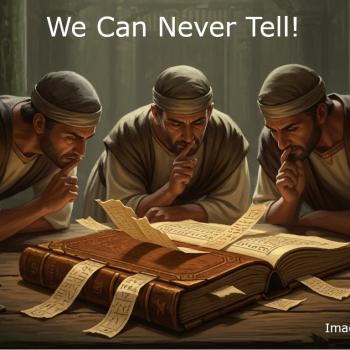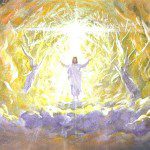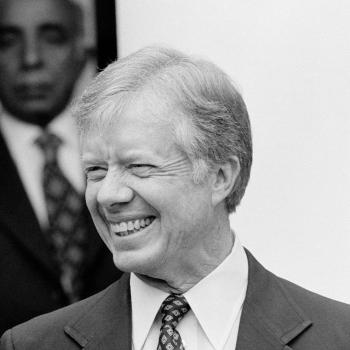Lectionary Reflections
Year C
November 6-12
Haggai 1:15b-2:9
I assume it is safe to say that the prophet Haggai is not in the top ten of your favorite books of the Bible, perhaps not even in the top thirty! It is tucked away in our Christian canon, between Zephaniah and Zechariah, its two brief chapters largely unexplored by many preachers. I imagine that 2 Thessalonians and Luke get the vast bulk of a preacher's attention on this particular Sunday in Year C. Yet, as always, these more obscure corners of the tradition can yield some very important and very timely ideas if we give them a chance. So, let's give old Haggai a closer look.
The name of the prophet has something to do with the common Semitic word for "feast" or "festival." (See the more famous Arabic equivalent word "hajj," added to the name of a Muslim who has completed a pilgrimage to Mecca.) He is well named, since his prophecy consists of one central idea; the temple must be rebuilt if God is to be honored properly. And after the temple is rebuilt, the proper feasts can once again be celebrated in the holy city, Jerusalem.
From this prophet, unlike his more famous forerunners -- Amos, Isaiah, Micah, Hosea, Jeremiah -- comes exactly nothing about a passionate concern for God's demand for righteousness and justice among God's people. While Amos shouts that God rejects the worship feasts of Israel (Amos 5), and Jeremiah warns against an over reliance on the temple of the Lord while justice is missing in the community (Jeremiah 7), Haggai claims that proper worship in the proper place is just what God demands. No wonder that Haggai is rarely read. He sounds like an apologist for those who think that going to church is the very essence of religious belief, regardless of how one behaves in the rest of life. But is it quite so simple as that?
It is important to reconstruct the context of the prophet's work. Precise dates are given in 1:1. Darius I's second year was 520 B.C.E., the sixth month is September, and on the first day of that month, Haggai received a word from God that was to be shared specifically with Zerubbabel, the governor of Judah, and Joshua, the current high priest of the city of Jerusalem. This history is crucial for our understanding.
Darius I, who became one of Persia's greatest rulers, had just the previous year succeeded Cambyses, who by most accounts was a far less liberal ruler than his predecessor, the famous Cyrus, the conqueror of Babylon and freer of the Jews from that city in 539 B.C.E. During this change of kings of the Persians, overlords of the eastern world, new hopes arose among all subject peoples. Now, perhaps, the sacred temple of God in Jerusalem, lying in ruins since its destruction by the Babylonians in 587 B.C.E., could be rebuilt.
Both Zerubbabel, a grandson of King Jehoiakin, who was taken into Babylonian exile nearly seventy years before, and Joshua, perhaps a direct descendant of the last high priest of Jerusalem before its destruction, took Haggai's words seriously and began the reconstruction "on the 24th day of the sixth month," twenty-three days after God's word was given. Working on the building with the governor and the priest were "the remnant of the people," presumably those who had returned to the shattered city and were anxious to see its former glory.
But problems soon arose. About twenty-eight days later (2:1), the temple, far from the grand and glorious place its memory suggested, appeared to many of the builders to be little more than a shadow of its supposed former grandeur. Haggai spoke again in a divine oracle, "Who is left among you who saw this house in its former glory?" Since almost seventy years had passed, the answer must have been that very few, if any, of these builders had ever seen Solomon's temple. That is why they said, "Is it not in your sight as nothing?" The building that the poor and struggling Israelites, recent refugees from Babylonian exile, were building was nothing like the glorious temple that their imaginations had conjured during all those exilic years. Surely this pathetic pile of mud brick and sticks could not be the temple they had longed for, prayed for, hoped for? And, of course, it was not that building at all.
And here is Haggai's answer for those hugely disappointed builders; it is a word that we find in many biblical places, but its power never fails to thrill:
Take courage, Zerubbabel; take courage, Joshua, son of Jehozadak, high priest; take courage, all you people of the land. Work, for I am with you, says the Lord of Hosts, according to the promise that I made you when you came out of Egypt. My spirit abides among you; do not fear! (Haggai 2:2-4)
Yes, Haggai wanted a rebuilt temple, but clearly not for its own sake. The bricks and mortar of any building have no meaning apart from the conviction that God has brought us out of the bondage of Egypt and remains with us still. No matter what this building looks like, God is here, and God is working.





